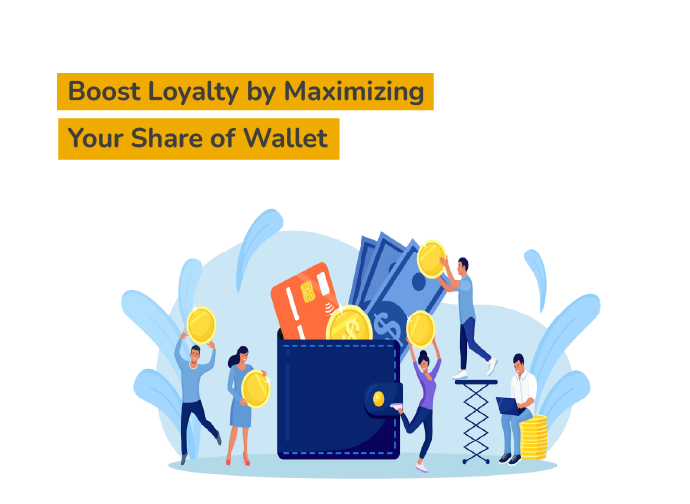What Does Share of Wallet Mean?
Share of Wallet refers to the percentage of a customer’s spending within a category that goes to a specific company. It’s a crucial metric in
business, as it allows companies to gauge their
market position and identify growth opportunities. Understanding Share of Wallet helps businesses tailor their strategies to capture a larger share of their customers’ expenditures. In this competitive market, knowing your Share of Wallet can be the difference between
stagnation and transformational growth. Companies that maximize this metric often see improved customer
loyalty and increased
revenue streams.
- Definition: Percentage of spending by a customer in a category allocated to a specific company.
- Importance: Gauges market position and unveils growth opportunities.
- Impact: Key to loyalty and increased revenue.
Key Takeaways
- Share of Wallet is a crucial business metric that represents the percentage of a customer’s spending captured by a company within a category.
- Maximizing Share of Wallet enhances customer loyalty and increases revenue by capturing a larger portion of customer spending.
- Calculating Share of Wallet involves identifying customer expenditure in a category and utilizing tools like data analytics for accuracy.
- Strategies to enhance Share of Wallet include cross-selling, upselling, developing strong customer relationships, and implementing personalized marketing.
- Technology, including CRM systems and data analytics, plays a significant role in boosting Share of Wallet by providing customer insights and fostering loyalty.
Definition of Share of Wallet
Share of Wallet is a crucial metric in business that represents the amount of a customer’s total spending within a category that is captured by a company. It indicates not just the proportion of a customer’s spending that goes to your business, but also highlights potential growth opportunities. Understanding and maximizing share of wallet is essential as it helps businesses increase revenue, strengthen customer loyalty, and outpace competitors. By focusing on this metric, companies can better target efforts to retain and expand their customer base effectively.
„Share of Wallet measures the percentage of a customer’s total spend captured by a brand within a particular category, helping businesses identify growth opportunities and improve customer retention.“
Importance of Share of Wallet in Business
Understanding the importance of
Share of Wallet in business is critical for enhancing customer loyalty and driving revenue growth. This concept refers to the portion of a customer’s total spending within a product category that is captured by a single company. By maximizing their Share of Wallet, businesses can secure a larger slice of their customers’ expenditure, leading to increased loyalty and stronger brand allegiance. This shift not only boosts profitability but also solidifies market presence. In a competitive business landscape, focusing on Share of Wallet can be the key to sustained success.
How Can You Calculate Share of Wallet?
Calculating the Share of Wallet is crucial for understanding how much of a customer’s spending is captured by your business as compared to competitors. By mastering this calculation, companies can tailor their strategies to increase market share. Start by identifying the total spend of your customer in your category, then divide your revenue by this total spend. Using effective tools and methods, like data analytics tools and customer surveys, ensures accurate results. Calculating Share of Wallet reveals untapped opportunities to increase loyalty and drive growth.
Step-by-step Guide to Calculating Share of Wallet
Calculating your
share of wallet is a vital process for businesses to comprehend how much of a customer’s spending in a specific category is captured by them.
Understanding this measurement helps in crafting strategies that can significantly boost customer retention. Initiating this process involves identifying your customer’s total available expenditure versus what they currently allocate to your brand. By leveraging these insights, businesses can uncover growth opportunities and design targeted efforts to cater more to each customer’s needs, thus enhancing their overall
customer experience and loyalty.
„A clear share of wallet strategy highlights its role in crafting personalized experiences, which directly ties into increased customer retention and loyalty.“
Tools and Methods for Accurate Calculation
Accurately calculating your Share of Wallet (SOW) is crucial for understanding how effectively your business is capitalizing on current customer spending. Comprehensive tools and methods streamline this process, ensuring precise insights. Utilizing advanced analytics tools, companies can assess their market position and make informed decisions to enhance customer loyalty. Key methods include data analysis software and customer surveys, which reveal spending patterns and preferences. Accurate SOW calculations foster strategic planning, allowing businesses to tailor their marketing efforts, ultimately boosting revenue and competitiveness.
Why Is Maximizing Share of Wallet Essential for Loyalty?
Maximizing your Share of Wallet (SoW) is crucial for enhancing customer loyalty, a vital metric for long-term success. By increasing the proportion of a customer’s total spending that occurs with your business, you solidify brand loyalty and create a more reliable revenue stream. Customers who spend more with a single brand are likely to exhibit stronger loyalty, reducing churn rates. Prioritizing SoW not only boosts profitability but also fosters deeper customer relationships and trust. Achieving this requires strategic efforts to integrate personalized engagement and targeted offers.
The Connection Between Share of Wallet and Customer Loyalty
Understanding the connection between
share of wallet and
customer loyalty can be pivotal for enhancing business success. Share of wallet signifies the percentage of a customer’s spending captured by a particular business relative to the total spending in that category. By maximizing this share, companies can significantly boost customer retention and loyalty. High share of wallet means stronger customer relationships, translating into sustained revenue and reduced customer churn. Therefore, businesses prioritizing share of wallet initiatives often see improved customer loyalty and higher lifetime value.
Benefits of High Share of Wallet
Achieving a high share of wallet is more than just increasing sales—it’s about solidifying customer loyalty and maximizing long-term value. When customers allocate a larger portion of their spending to your brand, it indicates trust and satisfaction, strengthening your relationship with them. This benefits businesses by fostering continued engagement, reducing acquisition costs, and increasing revenue. By prioritizing strategies that enhance the share of wallet, companies can create loyal customer bases and secure a competitive advantage in the market.
Which Strategies Can Enhance Share of Wallet?
Enhancing your share of wallet is pivotal for nurturing customer loyalty and ensuring business growth. Effective strategies include cross-selling and upselling, which expand the range of products or services a customer considers. Building strong customer relationships fosters trust, making clients more likely to choose your offerings again. Emphasizing personalization and targeted marketing further captivate customer interest, aligning products with their preferences. By implementing these strategies, businesses can capture a larger portion of consumer spending, ultimately leading to increased revenue and customer retention.
Cross-selling and Upselling Techniques
To elevate your business’s
share of wallet, implementing effective cross-selling and upselling techniques is fundamental. These strategies not only increase revenue but also enhance customer experience by offering clients products that complement their existing purchases or fulfill additional needs. Successful cross-selling involves suggesting related products that customers might find valuable, while upselling encourages them to opt for higher-end versions of the original purchase. Both methods, when executed accurately, foster stronger customer relationships and can significantly boost overall customer loyalty by maximizing the customer’s investment in your brand.
Building Strong Customer Relationships
Building
strong customer relationships is pivotal for any business aiming to maximize its share of wallet and foster customer loyalty. By nurturing these relationships, businesses can create a foundation of trust and satisfaction that encourages customers to spend more. Effective communication, providing exceptional service, and understanding customer needs are essential strategies. Businesses that invest in relationship-building can enjoy enhanced loyalty, increased spending, and greater market share. The key to success lies in recognizing the value of each customer interaction and leveraging it to strengthen bonds, thus ensuring long-term success.
| Strategy |
Benefit |
| Trust-building |
Encourages spending more |
| Exceptional service |
Enhances satisfaction |
| Understanding needs |
Tailors offers |
Personalization and Targeted Marketing
Personalization and targeted marketing are key strategies to boost your share of wallet. By understanding individual customer preferences and behaviors, businesses can tailor their offerings, creating more relevant and enticing promotions. This not only enhances customer satisfaction but also promotes brand loyalty, encouraging repeat purchases. Utilizing data-driven insights, such as purchase history and browsing behavior, allows for creating more personalized experiences, leading to increased customer spending and retention. Ultimately, implementing targeted marketing ensures that clients feel valued and understood, driving both revenue and long-term loyalty.
How to Measure the Impact of Increased Share of Wallet on Loyalty?
Measuring the impact of an increased share of wallet on customer loyalty involves tracking specific key performance indicators (KPIs) that provide insights into customer behavior and spending. By closely monitoring these KPIs, businesses can understand the correlation between loyalty and spending patterns. Analyzing changes in Customer Lifetime Value (CLV) and purchase frequency are essential to determine the true benefits of a higher share of wallet. This data-driven approach not only helps in refining strategies but also ensures that efforts to boost loyalty are effective and sustainable. Companies must adopt strategic methods to evaluate these metrics accurately.
Key Performance Indicators to Track
To effectively
measure the impact of your efforts to increase your Share of Wallet, tracking
Key Performance Indicators (KPIs) is crucial. Vital KPIs include the
Customer Retention Rate, which gauges how well you’re maintaining relationships, and the
Net Promoter Score (NPS), providing insights into customer satisfaction and advocacy potential. Additionally, monitor the
Customer Lifetime Value (CLV) to understand the financial benefit each customer brings over time. Keeping a close watch on these metrics helps fine-tune strategies, enhancing customer loyalty and ultimately maximizing profitability.
Analyzing Customer Lifetime Value Changes
Analyzing changes in Customer Lifetime Value (CLV) helps businesses understand the broader impact of an increased Share of Wallet. By examining CLV, companies can identify the tangible benefits of gaining a larger portion of customer spending, such as enhanced profitability and improved customer retention. Monitoring these changes reveals patterns that inform strategic decisions, ensuring that efforts to boost Share of Wallet effectively translate into tangible gains. Tracking CLV can be done by comparing historical data to current performance metrics, enabling businesses to gauge the success of their loyalty initiatives.
What Are Common Challenges in Increasing Share of Wallet?
Increasing your
share of wallet can be a formidable challenge due to various factors. One primary obstacle is
competition; businesses vie for the same customer spending, intensifying the fight for market dominance. Another significant challenge is
market saturation, which calls for innovative strategies to capture customer interest. Moreover, addressing
customer reluctance to spend more is crucial, as consumers may resist increasing their expenditure. Companies must understand these hurdles and adapt their strategies to effectively increase their share of wallet, thus boosting customer loyalty.
Addressing Competition and Market Saturation
In today’s highly competitive markets, increasing your Share of Wallet is crucial for sustaining growth. Businesses often face challenges like competition and market saturation which can limit their ability to capture a larger portion of customer spending. To tackle these barriers, companies must innovate their approaches by emphasizing differentiated offerings, understanding unique consumer needs, and agile adaptation to market changes. Effectively addressing these challenges can lead to enhanced customer loyalty and increased revenue streams. Leveraging comprehensive market analysis and strategic customer engagement are vital to overcoming these hurdles.
Overcoming Customer Reluctance to Spend More
Overcoming customer reluctance to spend more is crucial for businesses aiming to maximize their Share of Wallet. By addressing common customer concerns and fostering trust, companies can effectively encourage higher spending. The key lies in understanding the customer journey, anticipating needs, and offering solutions that add true value. Implementing targeted promotions and demonstrating the benefits of additional purchases are excellent strategies. Furthermore, educating customers about exclusive benefits and rewards can enhance their willingness to invest more, leading to increased satisfaction and loyalty.
Can Technology Aid in Boosting Your Share of Wallet?
Technology plays a crucial role in enhancing share of wallet by offering advanced tools and systems. By effectively utilizing CRM systems, businesses can gain deeper insights into customer behavior and preferences. Leveraging data analytics further aids in crafting personalized marketing strategies that resonate with individual customers. These tech-driven strategies not only help in optimizing sales but also in building robust customer relationships, therefore boosting both loyalty and revenue. Employing the right technology can transform customer insights into actionable strategies, ensuring that businesses capture a larger portion of their customer’s spending.
Utilizing CRM Systems Effectively
Businesses that aim to
boost their share of wallet (SOW) often turn to Customer Relationship Management (CRM) systems for strategic leverage. These systems
streamline customer data, enabling personalized marketing and enhancing customer experiences. By effectively utilizing CRM, companies can track customer interactions, preferences, and transaction histories. This leads to more
targeted promotions and strengthens customer loyalty, ultimately increasing SOW. Employing CRM systems right can decisively impact a business’s growth trajectory by fostering stronger relationships and encouraging repeat business.
Leveraging Data Analytics for Customer Insights
Harnessing the power of data analytics can be a game-changer in maximizing your share of wallet. By analyzing purchase patterns and customer behavior, businesses can gain valuable insights that lead to more personalized marketing strategies and better customer engagement. This data-driven approach not only enhances the customer experience but also fosters loyalty, ensuring customers spend more within your brand rather than turning to competitors. Employing the right analytic tools enables businesses to anticipate needs, recommend relevant products, and strategically position themselves in a competitive market.
FAQ
What is Share of Wallet?
Share of Wallet refers to the percentage of a customer’s spending within a category that goes to a specific company, helping businesses gauge market position and identify growth opportunities.
Why is Share of Wallet important in business?
Understanding Share of Wallet is crucial for enhancing customer loyalty and driving revenue growth, as it secures a larger slice of customers’ expenditures and solidifies market presence.
How can you calculate Share of Wallet?
To calculate Share of Wallet, identify the total spending of your customer in a category, then divide your revenue by this total spend, using tools like data analytics and customer surveys for accuracy.
What are effective strategies to enhance Share of Wallet?
Enhancing Share of Wallet involves strategies such as cross-selling, upselling, building solid customer relationships, and implementing personalization and targeted marketing.
How does technology aid in increasing Share of Wallet?
Technology aids in boosting Share of Wallet by utilizing CRM systems to gain deeper insights into customer behavior and employing data analytics for crafting personalized strategies.









